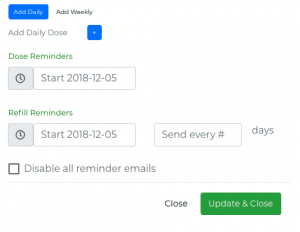![]()
A very common and alarming chronic disease of the respiratory system, asthma is one of the most dreaded which sends nearly 2 million people to emergency rooms each year. According to WHO, an estimated 235 million people suffer from this disease.
It is very common among children and occurs in almost all countries, regardless of socioeconomic status. Asthma is regarded as a substantial burden to most people and can even affect daily activities significantly.
Survive Asthma by Using the Inhaler Regularly
Asthma can either improve or worsen, depending on how patients handle it in the long run. Yes, there may be special treatments but only under the supervision of a specialist or pulmonologist. Aside from that, a unique feature in CareClinic guides patients as they go through with their daily lives. An asthma journal app comes in handy when you need to monitor your progress, as well as make it easy for your doctor to prescribe certain medications.
According to research, asthma actually results from a different host and environmental factors. This includes gender, obesity, and genetics as well. Atopy is the tendency to develop allergic diseases and is mostly linked to an IgE (immunoglobulin) – mediated response to allergens.
How does asthma occur? Air passages become inflamed which then results in a temporary narrowing of the airways, that bring oxygen to the lungs. Another feature of asthma is when there is airway obstruction. Allergy-causing substances and other triggers tighten the muscle bands in which air cannot move freely. This causes the person to have shortness of breath and wheezing sounds.
When there is airway irritability, even the slightest triggers such as dust, fumes or pollen can make the air passages narrow. People with asthma have very sensitive airways so any irritant in the air can trigger the disease.
Classifying asthma
Just like other diseases, asthma may also be classified into atopic, non-atopic or also a combination. Atopic asthma usually begins when you are a child and commonly linked to triggers that start off with wheezing. This usually happens when exposed to dust mites, pollen, pet dander, smoke or certain food/medications.
Upon exposure to a trigger, there is an excess release of IgE and initiates B – lymphocyte activation. IgE then binds to the cells related to inflammation. The release of inflammatory mediators occurs and triggers bronchoconstriction and airway inflammation.
Non-atopic asthma, on the other hand, does not have an IgE response. This usually happens in adults and according to research, it may be secondary to viral infections.
The Asthma Attack
An asthma attack occurs when the lining of the airways are already very swollen or inflamed plus increased mucus production. Once this happens, the patient has difficulty in breathing, as well as excessive coughing, wheezing and difficulty and eventually, a hard time doing normal activities.
Common symptoms among children and adults are:
- Severe wheezing
- Rapid breathing
- Chest tightness
- Pale, sweaty face
- Retractions
- Coughing that doesn’t stop
- Blue lips/fingernails
That’s why it is important to take in medications, such as the inhaler on time. CareClinic features the asthma symptom tracker which helps patients by sending reminders on when to inhale on time.
Mastering Asthma Management: Your Comprehensive Guide
For understanding asthma peak flow, CareClinic provides educational resources alongside practical tracking tools.>
Once diagnosed with asthma, specialists formulate an effective treatment plan or drug therapy. Some specialists also recommend monitoring the condition with a peak flow meter to measure how much air is pushed out of the lungs. If the airflow is below average, your specialist may suggest changing the treatment plan or having some environment or behavioral changes.
The Key Elements of Asthma Treatment
There are a lot of effective medications to treat asthma and it is divided between quick relief and long-term control medications. Aside from that, allergy shots (immunotherapy) are also very promising. Patients may be apprehensive when they want to take in synthetic medicines due to side effects.
Leveraging the Asthma Symptom Tracker App
But with the help of your specialist, you will be able to come up with a convenient treatment plan. This plan may work well with the patient’s asthma symptom tracker app. Knowing when and how frequently symptoms occur helps a lot in managing asthma.
For quick – relief of asthma, anticholinergics and short-acting inhaled beta 2 – agonists are usually prescribed. These are called bronchodilators which make the airways expand allowing more air to go to the lungs.
Optimizing Quick-Relief Medications
These medications also help clear mucus from the lungs. As much as possible, inhalers such as these type of medications must be on hand most of the time. These should be placed along with your wallet and car keys.
Some may treat their rescue inhalers as a crutch like taking 2 or more puffs many times in one day just to hinder symptoms. But always note it down that these only provide temporary relief. So if you want to effectively manage your asthma, your specialist must be able to provide you with a chronic, anti-inflammatory inhaled treatment.
Quick-relief medications, while effective for immediate symptom relief, do not address the underlying airway inflammation responsible for asthma symptoms. Therefore, alongside these medications, individuals with asthma should incorporate long-term control medications into their daily regimen. These long-term medications are essential for preventing asthma attacks and ongoing symptom management.
These are the following:
- Cromolyn sodium
- Antileukotrienes
- Inhaled corticosteroids
- Long-acting inhaled beta 2 – agonists
- Methylxanthines
- Immunomodulators
- Oral corticosteroids
These medications are taken every day, even if void of symptoms. A good thing about these medicines is that they reduce airway inflammation and then improve asthma control over time.
This is one of the features in CareClinic which sends reminders on the exact time to take the prescribed medications. Inhaling on time definitely prevents asthma attacks which are a hindrance to everyday activities.
Take medications the right way

Aside from saving the patient’s health records in the app, videos are also available and will pop up once the reminder goes off. According to research, 70% of asthma patients do not receive the full dose of their medications.
The prescribed medicine never reaches the patient’s lungs due to improper way of using the inhaler. That’s why with the help of this app, patients will be able to correctly use their inhalers every time.
When using the rescue inhaler, you must take a slow breath in, while simultaneously squeezing the inhaler to get that specific dose. The breath is then held for several seconds. Inhaling the right way will help get the medicine into the lungs instead of just at the back of your mouth.
With just a few minutes spent on watching the instructional videos, a great amount of information is learned. This amazing feature in CareClinic is very useful among many asthma patients who want to improve their condition gradually.
Jot down important data
When you are managing asthma, checking the pulmonary function regularly is highly advised. This is done to make sure that your medications are effective. Keeping track of the peak expiratory flow rate together with the symptoms you experience is important so that your doctor can check the prognosis of the disease. CareClinic features a health journal for asthma which comes in handy during consultations.
Printable data for appointments
The app is perfect if your pulmonologist wants to keep track of the disease. A PDF health report may be printed showing the peak flow rates. The report should also show how the symptoms developed throughout the course of the treatment. This health app is crucial in providing detailed information on your progress with regard to therapy or treatment given by your doctor.
It is important for patients to have a deeper knowledge of asthma. Patient education is crucial in an effective asthma treatment plan. Medical professionals must be able to teach patients and including their families how to recognize asthma signs and symptoms, as well as optimize environmental controls. Quitting smoking is one step in living a better life.
Asthma Tracker App Use Case
Patients must also receive annual vaccinations to avoid the complications acquired from respiratory diseases such as influenza and pneumonia.
Aside from that, health apps nowadays are very important for busy individuals. Writing down on paper takes a lot of time that’s why apps make it more convenient. Once your symptoms are tracked effectively in the app, your doctor won’t have a hard time in adjusting your treatment plan.
Using the app also helps you become wary of the early warning signs of an asthma attack. Frequent cough, reduced peak flow meter readings, wheezing, feeling upset, signs of allergies, and fatigue are just some of the early signs.
Asthma symptoms can escalate rapidly, necessitating prompt treatment for effective management. Individuals living with asthma should not resign themselves to the belief that their quality of life cannot improve. By diligently following the guidance provided by their healthcare provider and using CareClinic as a dependable asthma symptom tracker, individuals can experience substantial improvements in their overall well-being. This proactive approach, combined with specific medications tailored to their needs, can greatly enhance their quality of life.
With the ability to track and record asthma symptoms, medication usage, and environmental triggers, CareClinic empowers individuals to take proactive steps in managing their condition. This data-driven approach not only assists in timely symptom management but also enables healthcare providers to make informed adjustments to treatment plans. By leveraging the power of CareClinic alongside medical guidance, individuals with asthma can experience a substantial improvement in their quality of life, ensuring that they lead healthier and more fulfilling lives.


